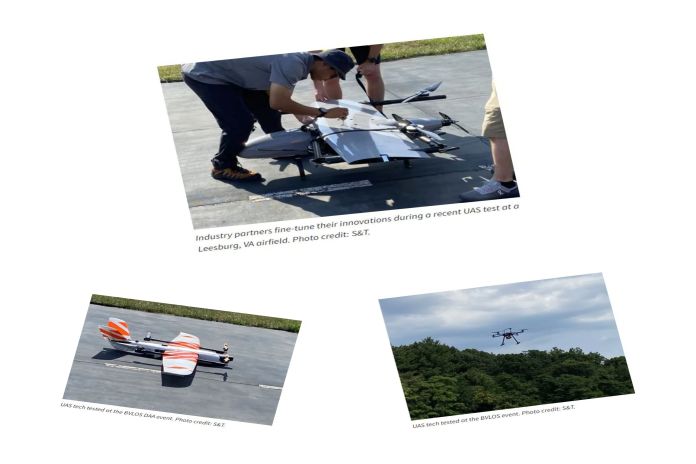![]()
S&T and HSWERX recently brought industry partners together to showcase aerial solutions in support of US Customs and Border Protection (CBP). More opportunities for public-private partnerships like this are on the horizon for 2025.
The terrain along our nation’s borders is vast and features a diverse array of geographies, ranging from grasslands, prairies, and lowlands to soaring mountains, rolling hills and forests. CBP is seeking a technological solution that would enable greater visibility across this expanse and the Science and Technology Directorate (S&T) responded.
In July, S&T and CBP invited selected companies to the Xelevate airfield in Leesburg, Virginia, to test unmanned aircraft system (UAS) sensors that could give field agents enhanced situational awareness beyond the visual line of sight (BVLOS). Onto the pavement they assembled, and each UAS whizzed up into the air to test how far it could go out-of-sight while still maintaining a clear picture of the landscape below while detecting and avoiding other aircraft.
This was the latest chapter in an ongoing partnership with HSWERX – the Homeland Security Innovation Hub – to identify aerial capabilities that will improve UAS safety and operations out in the field. HSWERX addresses these and other Department of Homeland Security (DHS) challenges by enabling the rapid discovery, engagement, and acceleration of innovative solutions to secure the homeland.
“These demonstrations give industry participants an opportunity to showcase their cutting-edge UAS and associated technologies, like specialized radar systems, infrared and electro-optical cameras, radio frequency detection systems, and acoustic devices,” said HSWERX program manager Christina heard. “Even more importantly, they enable S&T and CBP subject matter experts (SMEs) to evaluate the efficacy of these capabilities and their ability to aid and improve UAS and operator abilities to detect, identify, track, and avoid manned and unmanned aircraft in the field quickly and accurately.”
Creating pathways for innovators
The BVLOS two-day demo event was just one of many projects HSWERX manages for S&T to deliver cutting-edge technology to DHS components. The program connects DHS stakeholders with SMEs from industry, academia, and national labs to advance capabilities for end users. Established in 2021, the HSWERX Innovation Hub is a collaborative platform managed by S&T’s Technology Transfer & Commercialization Branch (T2C) through a Partnership Intermediary Agreement with DEFENSEWERX (DWX), a non-profit entity that enables agile innovation for several federal agencies.
HSWERX follows the DWX model by helping to shape requirements to support a request for technology submissions to address specific DHS problems. Once DHS identifies a gap and provides a problem statement, the HSWERX team recommends an appropriate mechanism for engagement. This can often involve a collaboration event (CE) to bring together government, industry, academia, national labs, and non-traditional performers to ideate. When ideas take shape and the needed technology solution is more clearly articulated, HSWERX coordinates with DHS to develop and release a Request for Information (RFI).
“HSWERX allows S&T to move with a speed and flexibility of collaboration among different types of partners not typical for a government agency, which results in technology solutions reaching the end user much faster,” said Chase Garwood, acting director of S&T’s Office of Industry Partnerships.
The development of these BVLOS technologies represents one of a variety of opportunities for the private sector to partner with S&T. Looking forward to 2025, HSWERX plans to host collaboration events to bring together the public and private sectors to discuss DHS problem sets, and assessment events, where DHS end users evaluate technologies against specified criteria to identify solutions that address DHS needs. A series of informational webinars is also being planned. “With a successful process now in place, T2C and HSWERX will be able to focus on outreach and engagement to grow the Hub in 2025,” said Garwood. “Even as more projects are submitted into the pipeline, the structure of HSWERX is such that we can move rapidly to solve the pressing problems facing homeland security.”
Next steps – the sky is the limit
The BVLOS demonstration involved eight industry participants, who were selected out of 22 submissions in response to the RFI. Each company was allotted a 90-minute timeslot to demonstrate how their solutions addressed CBP’s BVLOS needs, based on previously established assessment criteria. The significance of the technology drew other government agencies to the event, such as the Federal Bureau of Investigation, US Marshals Service, and NavalX.
At the successful conclusion of the BVLOS assessment event, CBP selected one of the participants to advance its BVLOS capability to the project and development phase through a business-to-business (B2B) agreement with HSWERX.
“The CBP technical lead will work with the appropriate SMEs and developers to create a prototype that can be presented to (and hopefully approved by) the Federal Aviation Administration,” explained Heard. “During this time, HSWERX will provide project management and general oversight until the final products are ready to transition to DHS end users.”
“We encourage traditional and nontraditional solution providers to join the HSWERX ecosystem to collaborate with DHS in meeting its mission needs.”





